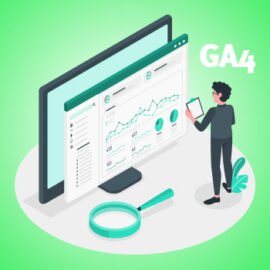
|
Getting your Trinity Audio player ready...
|
Did you know that companies that adopt Web Analytics are more assertive and more productive? After all, measuring audience behavior is essential to make better decisions and adopt strategies that bring better results.
In digital marketing, analyzing data is a mandatory task. In this article, we will talk about Web Analytics and understand how your analysis can change the game.
What is Web Analytics
I've read in some places that Web Analytics is linked directly to website data, through Google Analytics analysis. In part this is true. In reality, many people confuse what Web Analytics is with other concepts, such as Marketing Analytics, for example.
While Marketing Analytics is linked to marketing actions (which may or may not happen in the digital sphere), Web Analytics happens strictly in the digital sphere when we talk about its origin.
And why origin? Because this data, although it comes from the web, can even be processed in a spreadsheet, although there are great tools, such as Google Analytics. In times of big data, Web Analytics is increasingly consolidated as a thermometer of the actions that are carried out on the web.
It is also important to highlight that Web Analytics goes beyond the results shown by the tools. Data analysis uses tools, but those who interpret the data can also treat the information in other ways. Therefore, it is important to get out of the box when we talk about data analysis. If you're not happy with what you have at hand, take data processing and analysis to another level.
Thus, Web Analytics is the process of collecting, analyzing and interpreting data related to user behavior on websites and online platforms. It provides valuable insights into how visitors interact with a website, including how many people visit the site, where they come from, how long they spend on the site, which pages they view most frequently, and what actions they take during their visit.
Why Web Analytics is so important
I remember a History teacher I had who said: History aims to analyze past facts with the aim of understanding the present. Well, that's what Web Analytics is all about. Analyze past events to understand its impact, understanding what is happening. And more: with the aim of correcting or improving strategies to obtain better results.
It is interesting that data analysis not only allows us to understand what is wrong. Finding what is working is very important, as it allows you to expand the results. You can discover a preference of yours persona or notice a type of behavior in a landing page, for example, by tweaking your campaign, which could increase a conversion rate.
Thus, the main objective of Web Analytics is to better understand a website's performance, identify areas for improvement and make informed decisions to optimize the user experience and achieve business objectives. These goals can range from increasing website traffic to improving conversion rates such as sales, lead generation or signups.
Web Analytics tools collect data through tags and scripts placed in the website's code, which track users' activities. This data is then processed and presented in reports and dashboards, where website owners can analyze it and extract relevant insights.
In addition, Web Analytics can also be used to test and evaluate the performance of online marketing campaigns, identify market trends, understand the target audience profile and monitor the effectiveness of SEO (Search Engine Optimization) and SEM strategies ( Search Engine Marketing). In short, Web Analytics is an essential tool for guiding business decisions and maximizing online success.
How to analyze the data
To help organize the analysis, we have some important points to include the task in your routine:
Plan your analysis
There are, broadly speaking, two types of analysis in Web Analytics: predictive analytics and the prescriptive analytics. Predictive analysis helps to understand the macro and the second, the micro. In predictive, the main objective is to summarize the data obtained, which would allow room for corrections, before moving on to the details. Prescriptive analysis aims to understand the details of a given result.
Define the metrics
To define metrics, you first need to consider what your marketing objectives are. Without them, data analysis will be empty and always biased. There is no point in increasing traffic, for example, if the objective is conversions. There is no point in having many conversions if they do not result in sales and the objective was to sell.
Monitor
Always keeping an eye on what is happening helps to make adjustments. Furthermore, you must do this in a planned and organized way. Be disciplined.
Choose the tools
You can use a set of tools or just one. The important thing is to have the same data analyzed for comparison. You can use, in addition to Google Analytics and Facebook Analytics, for example, other tools such as Hotjar and the Kissmetrics. Excel is also valid.
Other good tool tips are Tableau, which allows integrations with Salesforce and Hadoop, and Google Attribution, a platform that allows you to combine information from different data sources.
What are the main metrics to be analyzed
Web Analytics work, as we have already shown, goes beyond the most well-known tools. Likewise, it goes beyond the usual metrics. But it's important to have a starting point. Here I suggest some KPIs (Key Performance Indicator), which can be used to start the Web Analytics work.
Customer Acquisition Cost (CAC): CAC shows exactly the amount spent to acquire a customer. To check the value, you must include all investments to attract new customers and divide them by the number of new customers.
Lifetime Value (LTV): Knowing how long and how much the time your customer was active in your base was worth is essential to determining the longevity of the business. Furthermore, LTV is a rate that helps you understand whether the business is doing well, whether customers are satisfied and what the churn rate is (loss of revenue or customers).
Return Over Investment (ROI): Return on investment, or simply ROI, is the famous rate of return. It helps to understand how much results a campaign is delivering, in a tangible and assertive way.
As we saw in this article, Web Analytics is essential for understanding and improving business in digital marketing.
Did you like this article? How about signing up to receive other cool content from Vero Contents? Just fill out the form to join our VIP list.

Marcel Castilho is a specialist in digital marketing, neuromarketing, neuroscience, mindfulness and positive psychology. In addition to being an advertiser, he also has a Master's degree in Neurolinguistic Programming. He is the founder and owner of Vero Comunicação and also the digital agency Vero Contents.




Comments are closed.